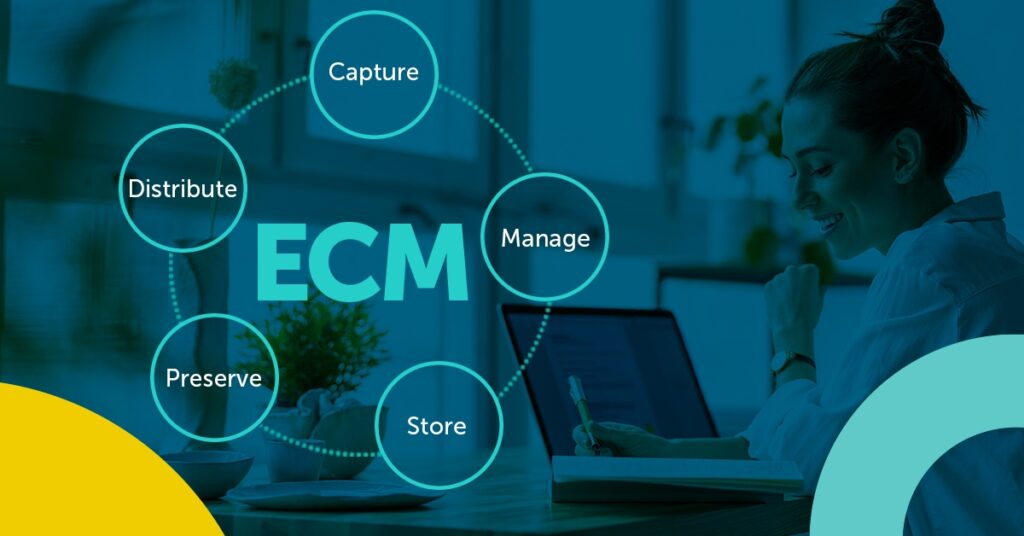Internal data and distributed content such as sales numbers, legal documents, financial reporting, and customer-facing content are the driving forces behind your organization. But as the organization grows and collects more data, there comes a greater need for management.
Effective content management goes beyond simple governance, distribution policies, or well-managed spreadsheets. Midmarket and enterprise organizations must support those policies with robust technology to succeed. Decentralized and ad hoc systems may work for a while, but you must organize and centralize your asset and information libraries to maximize their usefulness.
At one time, the answer to this challenge was traditional enterprise content management (ECM). It helped companies organize data, information, and assets to improve operations. However, with digital content now at the forefront of both internal business needs and customer-facing communications, ECM is undergoing an evolution.
What is traditional enterprise content management?
Traditional enterprise content management (ECM) is a collection of methods, tools, and strategies that allow organizations to maintain and manage internal company information. It has been used to enable business goals and outcomes necessary for success.
- Create access to cross-functional data for developing and meeting KPIs.
- Help creative teams share and collaborate on documents with confidence.
- Enable access to legal contracts for more effective negotiation and renewals.
- Help customer-facing teams search and access resources for support and sales.
- Give decision-makers access to the raw data, reporting, and documentation needed to drive change.
The goals of traditional ECM were to increase the quality and reliability of business data, promotes access to the right information, and reduce negative business impacts from incomplete, incorrect, or misused information.
Top elements of a traditional ECM
In a traditional ECM, these five pillars—as defined by the Association for Intelligent Information Management (AIIM)—govern all information handling:
- Capture business documents and information in a digital format. This includes digitizing paper documents with an optical character recognition (OCR) scanner. It also includes collecting digital documents into consistent file structures and formats. Tagging files with metadata or enabling full-text search makes the documents accessible.
- Manage captured data in an effective and streamlined manner to accomplish the following:
- Create access to view documents.
- Establish records management policies and workflow.
- Grant access permissions to users.
- Establish document deletion policies, etc.
- Enable “digital decluttering” of duplicate files.
- Store documents and information in a safe and access-controlled repository or file management system. Records retention may occur on-premises or in a cloud-based content services platform. A SaaS ECM platform gives your on-premises and remote employees access to stored materials for use and distribution.
- Preserve current and historical information. It also includes a way to save backups for regulatory compliance and to aid in disaster recovery.
- Distribute data to necessary internal and external stakeholders on demand. Delivery happens through automated workflows, a user-accessed document management system, a brand portal, or collaboration platforms such as digital asset management (DAM) systems.
The evolution of DAM and ECM
ECM and digital asset management began as siloed sets of technology and process, with ECM delivering access to business documents and digital asset management empowering access to media files.
The way we interact with our information and assets is changing, eliminating the need to treat ECM and DAM as separate entities. The evolution of modern content management makes it possible to bring together business information and digital assets under one platform, breaking down silos and providing the benefits of modern asset management across the organization.
A robust DAM, enabled with an ecosystem of features of integrations, can successfully handle both your traditional ECM goals and your wider asset management needs in one place.
Benefits of modern content management
Many of the goals of traditional ECM remain relevant in the modern business and marketing environment. However, the content in question is no longer limited to documents or text but a wide range of digital assets and document formats. Also, modern content management isn’t just for enterprise-sized organizations. SMBs and mid-market businesses find equal benefits to a robust content management approach.
Content operations and content management enable your organization to pursue its objectives with confidence. It gives teams the visibility, data access, and communication tools necessary to create value, reduce spending, and facilitate change.
Organizations realize many benefits by moving to a modern solution:
Reduce costs
Data management is expensive and time-consuming. By implementing good content management and governance policies, organizations reduce the time spent searching for information. Optimized time reduces data storage costs and costs associated with lost productivity.
Increase efficiency
Streamlining information management processes leads to greater efficiency. It gives teams and decision-makers easier access to the information and digital assets they need to perform their roles. This reduces cycle times for budgeting, product planning, marketing development, legal review, financial audits, and other critical internal and customer-facing functions. It also enables the content creation process to power marketing and drives revenue.
Improve security
Content management systems offer safer storage and distribution of information. They reduce the likelihood of secure information going missing or becoming compromised. Better security measures are a cost avoidance strategy, and they reduce time-consuming mitigation measures due to data breaches.
Enable communication
Centralizing and organizing data simplifies communicating information across your organization. With a dynamic permissions system, only authorized end users can access documents. This ensures the right stakeholders work together without communication logjams.
Empower decision-making
Accessing accurate and up-to-date information creates visibility for better decisions. Managing data with effective content strategies and cross-departmental communication lets organizations plan with transparency and confidence.
Modern use cases for content management
There are several use cases for content management solutions across many departments:
Accounting
Financial departments need secure access to the company’s most sensitive data and documents. This may include invoices, purchase orders, budgets and forecasts, investment information, and contract and legal documents. Intelligent information management means teams access the correct information for their needs.
Customer-facing teams
Customer service and sales teams routinely encounter sensitive customer data. Content management solutions allow them to access historical customer data for tasks such as account history research and customer support tasks. ECM also enables access to promotional or support materials for customer education.
Distributed and remote workers
As the world shifts toward remote-first and hybrid work environments, content management software provides secure, remote access to business documents from any location or device. These teams rely on fast, secure access to the documents required to drive business processes.
Talent management
HR, payroll, recruitment, and retention teams handle sensitive information. These teams depend on secure storage and easy file access to navigate stringent regulations. Features such as secure encryption and role-based access control ensure that only authorized employees have access to privileged or personal information.
Governance
Digital asset governance ensures that creative teams are using the right assets and copyrighted material in their work, and doing so in a compliant, on-brand manner. A digital asset management solution with DRM ensures these guardrails automatically, providing the right balance of access and security.
This approach works for Information governance as well. A robust digital repository provides a source of truth for sensitive business intelligence and documents. It gives necessary stakeholders access to historical document capture to convert paper documents into digitized formats.
They may also need long-term retention of records for compliance purposes. With an automated solution, these teams can store data securely and delete it automatically when retention periods have elapsed.
Marketing
Marketing teams work to deliver relevant messaging that complies with internal and external requirements. Digital asset management (DAM) allows them to access and repurpose digital assets and documentation used to create compliant, high-performing campaigns and marketing materials.
The future of content management with Aprimo
As organizations move toward a unified DAM and ECM approach, they can take advantage of robust features that operationalize efficiency, save money, and increase the productivity of their teams. With the right foundational software, organizations can significantly improve how they manage the entire content lifecycle – from idea to experience, on one streamlined platform.
Digital asset management (DAM) is a central component of this plan, allowing teams to collaborate, plan, manage, and deliver first-class customer experiences, all while pulling back in valuable creative production and content performance insights back in to inform future campaigns and smarter ways to work. A modern DAM allows you to maintain compliance, reduce redundancy, and empower all stakeholders with access to the best information and resources.
If you’re ready to embrace the future by combining your business information and digital assets into a single, powerful system, start with a free trial of the Aprimo platform.


